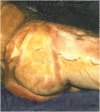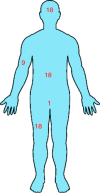A general overview of burn care
- PMID: 16618325
- PMCID: PMC7951672
- DOI: 10.1111/j.1742-4801.2005.00129.x
A general overview of burn care
Abstract
The majority of burn victims do not need to be treated in a burn centre. Adequate care can be given by non specialised medical personnel, provided that proper guidelines are followed. The article outlines and reviews these guidelines.
Figures
References
-
- Rockwell WB, Cohen IK, Ehrlich HP. Keloids and hypertrophic scars: a comprehensive review[see comments]. Plast Reconstr Surg 1989;84(5): 827–37. - PubMed
-
- DeToledo JC, Lowe MR. Microwave oven injuries in patients with complex partial seizures. Epilepsy Behav 2004;5(5):772–4. - PubMed
-
- Josty IC, Mason WT, Dickson WA. Burn wound management in patients with epilepsy: adopting a multidisciplinary approach. J Wound Care 2002;11(1):31–4. - PubMed
-
- Sances A Jr, Myklebust JB, Larson SJ, Darin JC, Swiontek T, Prieto T, Chilbert M, Cusick JF. Experimental electrical injury studies. J Trauma 1981;21(8):589–97. - PubMed
-
- Sykes RA, Mani MM, Hiebert JM. Chemical burns: retrospective review. J Burn Care Rehabil 1986;7(4):343–7. - PubMed
Publication types
MeSH terms
LinkOut - more resources
Full Text Sources
Medical




